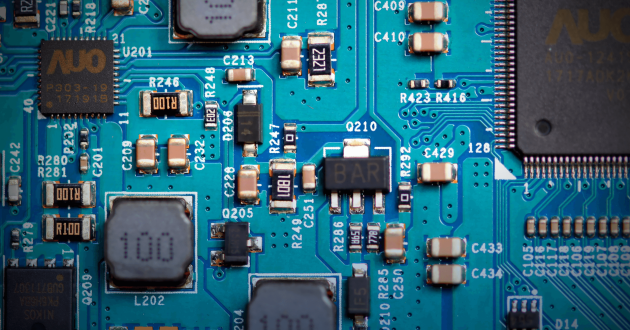What is the CHIPS and Science Act?
The Creating Helpful Incentives to Produce Semiconductors and Science Act of 2022 (CHIPS and Science Act) was signed into law on August 9, 2022. The goal of the CHIPS Act is to revitalize the US semiconductor industry by increasing semiconductor manufacturing and development in the US and advancing the country’s competitiveness in developing these technologies. The act is also aimed at helping the US respond to the economic and national security issues resulting from the demise of its semiconductor industry, which has seen substantial shifts to other countries over the past few decades, primarily China.
>> Read our research into the ownership networks of 35,000 semiconductor firms in China <<
The CHIPS Act invests $280 billion into the industry over the next ten years. About $200 billion is for scientific research and development. About $52.7 billion is for semiconductor manufacturing and workforce development, with another $24 billion worth of tax credits for chip production. There is also $3 billion slated for programs aimed at leading-edge technology and wireless supply chains.
The recipients of the funding from the CHIPS Act are prohibited from expanding semiconductor manufacturing in China and other countries determined to pose a national security threat to the United States. These restrictions apply to funding recipients for 10 years from the date of funding. The CHIPS Act also outlines that these restrictions are subject to change if the Secretary of Commerce, in coordination with the Secretary of Defense and the Director of National Intelligence, finds that it would be wise to expand restrictions to other technologies.
Why is the CHIPS and Science Act important?
The CHIPS and Science Act was enacted in response to the fact that the United States now makes only 12 percent of the world’s semiconductors, compared with 37 percent in the 1990s, according to an executive report. McKinsey research estimates that worldwide demand will keep growing, with semiconductors poised to become a $1 trillion industry by the end of the decade.
Since the Act’s passing in 2022, it has prompted research institutions and businesses across the country to work towards bolstering semiconductor manufacturing, STEM job creation and workforce development, and advancing new technologies. Many US firms are dependent on chips made abroad, and the fragility of those supply chains has become increasingly evident over the past 2 years.
While businesses need to consider whether the potential value of federal funding would sufficiently offset geographical manufacturing constraints, additional legislation might force their hands. Export controls issued by the Biden administration in late 2022 caused suppliers of chip-making equipment to stall any servicing of Chinese chip factories. These restrictions from the US Department of Commerce’s Bureau of Industry and Security are said to be among the toughest the United States has ever enacted.
This new rule issued by BIS imposes complex new export controls that impact advanced computing integrated circuits (ICs), computer commodities, semiconductor items and related manufacturing equipment, and supercomputers. It also imposes heightened knowledge standards and due diligence requirements for U.S. businesses who want to export to China. Now more than ever, it’s important for Western suppliers to conduct investigations into their Chinese partners to ensure compliance with the new restrictions.
How can I ensure I’m in compliance with the CHIPS and Science Act?
If your business is receiving funding from the CHIPS and Science Act, you’ll need to ensure you remain compliant with restrictions on Chinese and other international semiconductor and chip manufacturers.
In recent years, Beijing has made China’s semiconductor development and manufacturing capabilities a priority, in part due to US export controls limiting China’s access to US technologies. The number of companies that have registered as semiconductor firms in China has increased by 700 percent since 2010, according to an analysis by the Financial Times. This makes the task of pulling away fromChinese manufacturing supply chains even more challenging.
>> Learn about China’s largest semiconductor investment fund <<
It would be impossible to remain in compliance with semiconductor export laws if you didn’t have all of the information on the associated importers, exporters, and buyers. A commercial risk intelligence platform, such as Sayari Graph, leverages global public records and graph technology to pre-compute complex, cross-border corporate networks, thus providing a clear picture of companies in both the public and private sectors, their infrastructure, and relationships. This comprehensive view provides importers with broader context surrounding their partners and counterparties. If you’re looking to stay in lock step with regulators, BIS also relies on Sayari Graph data for regulating trade.
U.S. regulators, including BIS, have additionally emphasized the risks of doing business with Chinese military-industrial complex companies and state owned enterprises (SOEs). While there is an explicit list of Chinese military end users (MEUs) to avoid, this list is non-exhaustive and the burden to ensure customers are not military end users falls on the exporter.
Sayari Graph can help enrich BIS MEU, NS-CMIC, Section 1260H, and other regulatory lists with complete subsidiaries, joint ventures, branches, trade partners, and affiliates. This allows exporters to quickly uncover hidden trade counterparty connections, including transshipment risk and geographic proximity to designated entities. Additionally in Graph, users can upload counterparty lists for efficient bulk screening for entities located in a military innovation zone.
To learn more about how to run supply chain investigations in China, watch our Masterclass to learn what you can uncover with Chinese public data.



